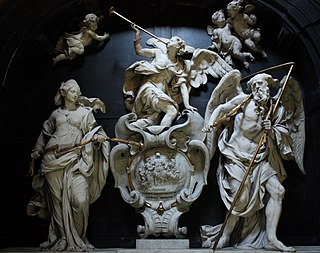
St. Rumbold's Cathedral is the Belgian metropolitan archiepiscopal cathedral in Mechelen, dedicated to Saint Rumbold, Christian missionary and martyr who had founded an abbey nearby. His remains are rumoured to be buried inside the cathedral. State-of-the-art examination of the relics honoured as Saint Rumbold's and kept in a shrine in the retro-choir, showed a life span of about 40 years and a death date between 580 and 655, while tradition had claimed 775 AD.

Le Déjeuner sur l'herbe – originally titled Le Bain – is a large oil on canvas painting by Édouard Manet created in 1862 and 1863. It depicts a female nude and a scantily dressed female bather on a picnic with two fully dressed men in a rural setting. Rejected by the Salon jury of 1863, Manet seized the opportunity to exhibit this and two other paintings in the 1863 Salon des Refusés, where the painting sparked public notoriety and controversy. The work is now in the Musée d'Orsay in Paris. A smaller, earlier version can be seen at the Courtauld Gallery, London.

Lucas Faydherbe was a Flemish sculptor and architect who played a major role in the development of the High Baroque in the Southern Netherlands.

Rombout Verhulst was a Flemish sculptor and draughtsman who spent most of his career in the Dutch Republic. There he helped introduce the Baroque style in sculpture while becoming the leading sculptor of marble monuments, including funerary monuments, garden figures and portraits.

Andreas Creusen (1591–1666) was a Dutch Catholic clergyman.

Lucas Franchoys the Elder or Lucas Francois (1574–1643) was a Flemish painter of history paintings and portraits.

The Lessius Mechelen is a university college located in Mechelen, Belgium.

Our Lady of Leliendaal Church is a Roman Catholic church in Mechelen, served by the Society of Jesus. It was designed by Lucas Faydherbe and is protected structure; described by the city council of Mechelen as one of its 8 historic churches.

Rombaut Pauwels or Rombout Pauwels was a Flemish architect and sculptor who worked in a moderate Baroque style. Rombaut Pauwels was active mainly in his hometown Mechelen and in Ghent.

Mattheus van Beveren was a Flemish sculptor and medalist who is mainly known for his monumental Baroque church sculptures and small wood and ivory sculptures. He also made medals and die designs for the Antwerp Mint.

Artus Quellinus II or Artus Quellinus the Younger was a Flemish sculptor who played an important role in the evolution of Northern-European sculpture from High Baroque to Late Baroque.

Jan Anthonie Coxie or Anthonie Coxie was a Flemish painter and draughtsman mainly known for his portrait and history paintings. After starting his career in Flanders he moved abroad and worked in Amsterdam, Berlin, Mainz and Milan where he worked for an elite clientele.
Hendrik Faydherbe or Henri Fayd'herbe (1574–1629) was a Flemish sculptor and gilder, and poet, who lived and worked in Mechelen, in the Southern Netherlands.
Maria Faydherbe, referred to in the French literature as Marie Fayd'herbe (1587–1643) was a Flemish sculptor who lived and worked in Mechelen, then a city in the Southern Netherlands.

Frans Langhemans was a sculptor from Mechelen.
Faydherbe or Fayd'herbe is a surname. Notable people with the surname include:

Bust of Hercules is a terracotta sculpture by Lucas Faydherbe (1617–1619) and makes part of the Van Herck Collection acquired by the King Baudouin Foundation in 1966.

Laurence Vander Meulen, born in Mechelen in 1643 and died in his hometown in 1719 was a Flemish sculptor.

Jan van Delen was a Flemish sculptor who is mainly known for his Baroque church sculptures, allegorical scenes, funeral monuments and portraits. He was principally active in Brussels where he popularized the Flemish Baroque style in sculpture.
















